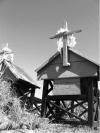Araucanía (Chile) and his territory: a contrast between the ethereal and the material thing
##plugins.themes.bootstrap3.article.details##
Abstract
AbstractThe Araucania, located to the south of Chile, is one of the territories which owns greater cultural diversity as a result of thecolonization process that gave a hallmark to this zone at the end of xix century. This can be appreciated in different manifestations;most of them find their maximum expression through architecture, which reflect a complex reality full of rites, sentimentalismand traditions as European as Chilean or Mapuche, that mix together in a multiethnic landscape. Old stations, historicalneighbourhoods, forgotten country estates and peculiar cemeteries constitute the mentioned sceneries, and these are therichest ones, capable of synthesizing the relationships among several societies which manage to be united reaching a culturalsyncretism that should be understood as a the Arauncania’s distinctive. This bond with the space, the relationship with theenvironment and the modification of this, have generated, that in this 127 years of immigration, exist a permanent dialoguethat can go beyond the time through social residual spaces, which are valuable sources to rebuild the history and understandthe construction of one of the most heterogeneous territories of South America. C
Keywords
Colonización, sincretismo cultural, territorio. - Descriptores, Araucanía, territorio, América del Sur.olonização, o sincretismo cultural, território, Palavras-chave descriptor, Araucanía, um território, a América do Sul.olonization, cultural syncretism, territoryKey words plus, Araucania, territory, South America
References
How to Cite
Rodríguez Domínguez, C. P. (2010). Araucanía (Chile) and his territory: a contrast between the ethereal and the material thing. Apuntes: Revista De Estudios Sobre Patrimonio Cultural, 23(2). Retrieved from https://ojspuj.repositoriodigital.com/index.php/revApuntesArq/article/view/8897
Section
Artículos


